Today forgotten, in the Middle Ages it was considered one of the most glorious. The glow of this victorious battle only dimmed due to the success at Grunwald.
On June 19, 1205, an unusual painting could be seen near Zawichost. On that day the Vistula became almost black from the people. Thousands of soldiers hurried across the river. Some sailed on boats and canoes hastily made up or taken from peasants from nearby settlements. This year's spring was warm, and the water level was low, so there were also those who fordered to get to the opposite shore sooner.
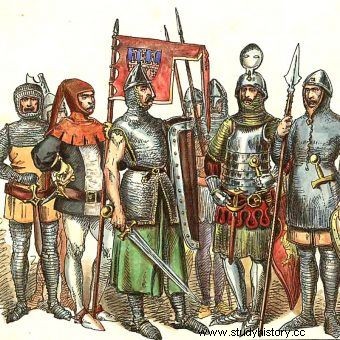
The armament of the Polish knighthood from 1228–1333. This is what the army defending Zawichost could look like. Illustration from the book "Polish triumphs".
The Prince of Halych, Roman, led a powerful (for medieval conditions) army - 13,000 combatants. While serving under Roman's banner, there was no shortage of opportunities to gain experience. In three decades, this ruler traveled a long way from the insignificant prince of Volhynia to one of the most powerful men in all of Russia. He conquered Halicz, took control of Kyiv, organized victorious expeditions against the nomadic Polovtsy ...
Against the background of earlier conquests, the invasion of Poland appeared to be an exceptionally simple task. After entering the lands of the Piasts, two forts were easily captured, and on the other side of the Vistula, more settlements were waiting to be plundered. Roman's only worry - if you trust the account of the 15th-century chronicler Jan Długosz - could be the dream he had the previous night. And he dreamed that "a handful of red-headed birds, which we call goldfinch, flew in from the side of Sandomierz and devoured a very large number of sparrows".
At dawn, he told his friends about it:most of the young people considered the night awaiting a good omen, while the older ones became worried with their age, seeing in it a harbinger of Polish victory.
The prince's scouts could have thrown the prince out of any possible deliberations, who brought the surprising news:Poles are coming!
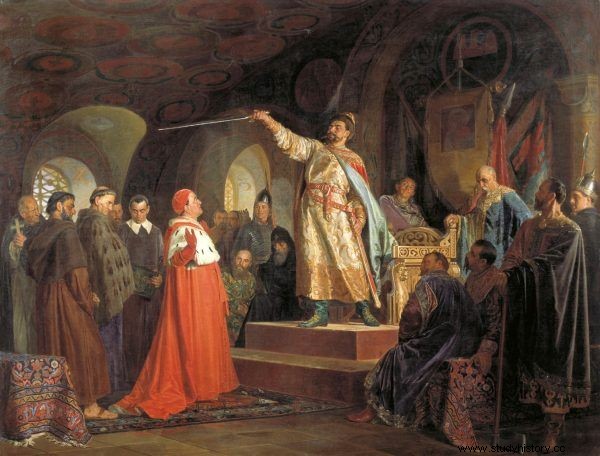
Duke of Halych, Roman Mścisławowicz, painted by Nikolai Newrew.
Roman did not believe them, saying the attack was more than ruled out. On June 19, the martyrs of Gervase and Protasius were celebrated. It was hard to imagine that the Polish knights would want to fight on such a solemn day. The Russian ruler, like the apostle Thomas, did not believe it until he saw it. And then he felt fear.
Only chance
Roman's invasion was directed at the Sandomierz district, which was then ruled by prince Leszek Biały, who was about 20 years old. The younger brother Konrad, ruling Mazovia, rushed to help the attacked. Both Piasts had little war experience, which is not surprising in the context of their age, which is why the command was entrusted to voivode Krystyn, coming from the Gozdawa family (according to Długosz) or the Łabędziów family (according to some historians).
The majority in numbers was on the side of the Ruthenians and no one in the Polish camp was deluding who would win if the fight took place in an open field. However, as Krystyn pointed out, it was possible to eliminate the enemy's advantage.
It was enough to strike when Roman's army would cross the Vistula. Surrounded by a river, a steep slope and hills reaching all the way to the Vistula River itself, the enemy would not be able to develop lines or even attract all his subordinates to fight.
There was only one chance for success. And the Poles were not going to lose it.
Prince on the old jug
Polish warriors first greeted the Ruthenians with an avalanche of arrows. Roman's men rushed to grab their shields. some of the iron arrowheads found their way to their destination by hitting the invaders. It was, however, merely an overture to the actual showdown. Both troops shouted and charged each other with spears.
In a fight in a small space, the chances were even. And although Roman was introducing more troops into the battle to replace those depleted by Poles, the scales of victory slowly tilted towards the warriors led by Krystyn. As Długosz reported:
Prince Roman saw that he was in a very serious danger when the entire squad of knights that gathered around him defended him so far and was perfectly destroyed by the Poles. The most persistent and brave defenders died in front of the prince, and piles of corpses on both sides prevented prince Roman and his other Ruthenians from escaping.
Among this, Prince Roman saw that he was seriously endangered - for the horse he was sitting on, kicked with his heels over and over, wanted to throw him off - having broken through the middle of the ranks reaches the Vistula River, where the horse died and left the prince.
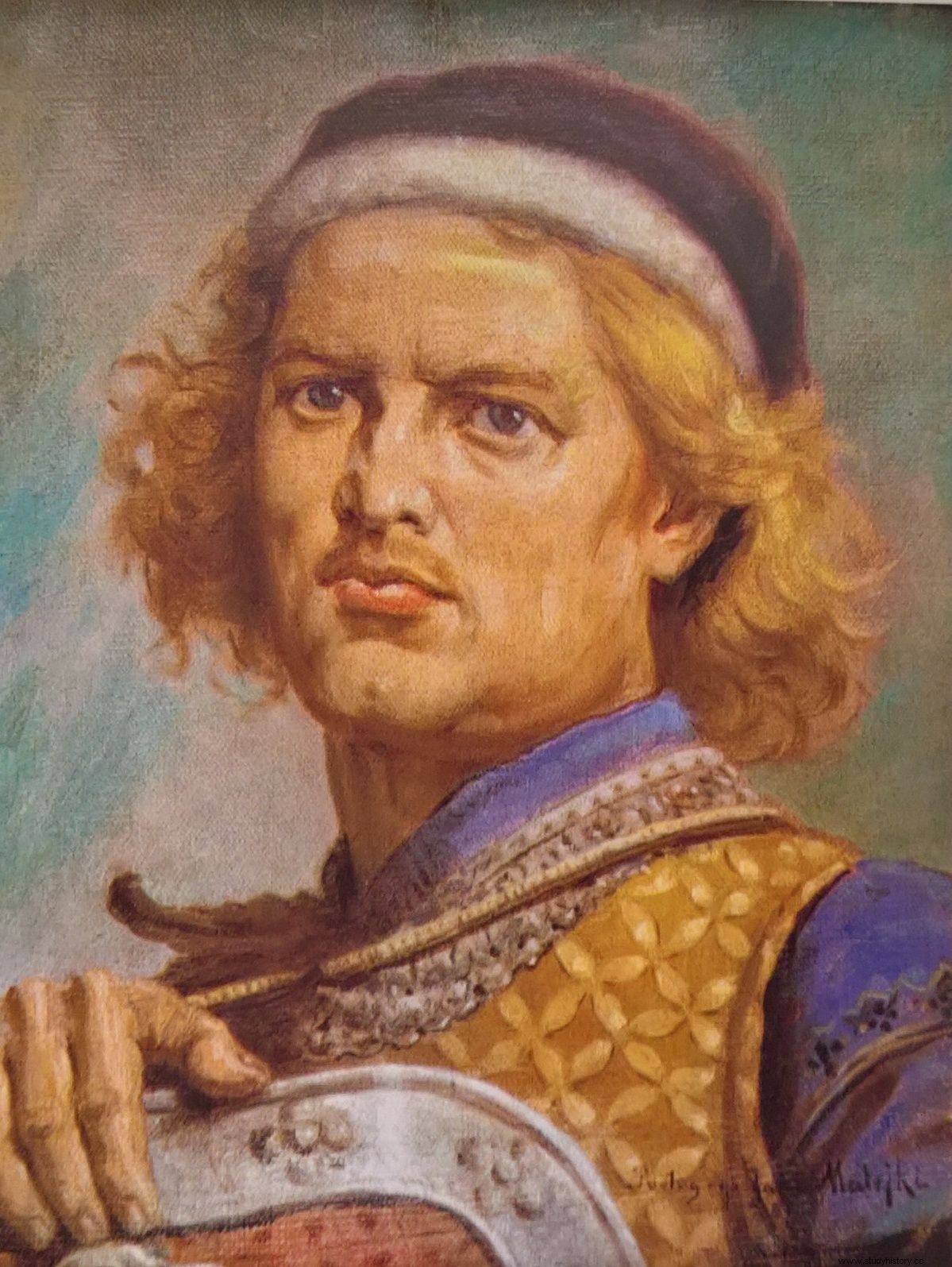
Book Leszek the White, he commanded the Polish army at Zawichost.
Faithful warriors quickly brought Roman an old hack, on which he had difficulty crossing the Vistula River. The mare is said to have "thanked like a mother for saving". It was a signal to his men who ran in a disorderly flight by jumping into the river. Anyway, only for some of them:while a heavy fight was taking place on one shore, on the other side there was still a large part of the Russian army, watching helplessly as their countrymen try to avoid Polish swords, axes and javelins ...
Those who were still in combat were killed by the knights of Leszek and Konrad. Nature itself struck unexpectedly on those who retreated. The ground by the river, torn by horse hooves, could not bear the weight and collapsed, dragging a lot of Roman's men with it.
In a battle amok, the Poles crossed the Vistula River and set off in pursuit of the scattered groups of Ruthenians. Some of them caught up and murdered them. So also died Prince Roman, who was taken for a simple soldier and hacked.
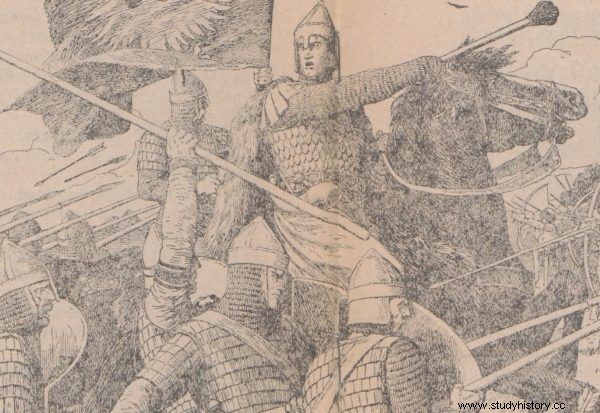
By choosing the right strategy, the Polish army achieved a full victory.
In the evening of that beautiful day, on the banks of the Vistula River, the victorious Poles stumbled over piles of the corpses of their enemies and their own, and the river was reddish with the blood of the fallen. The discovered body of Roman was ordered by Duke Leszek the White to be buried in Sandomierz. Later, the body of the fallen ruler was exhumed and exchanged for Polish prisoners of war taken into Ruthenian captivity on the occasion of other expeditions.
Two perspectives
Historians differ on the importance of the victory won in June 1205. As Leszek Słupecki wrote:
The almost forgotten Battle of Zawichost belongs [...] to the most important battles of the Polish army in the 13th century. The triumph over the Prince of Halych, Roman, who fell in its field, was also one of the greatest victories of the Polish army in history.
The battle has become legendary - it was made famous by the songs known back in the times of Jan Długosz, and the fame of the victory at that time was only overshadowed by Grunwald .
On the other hand, there are also some researchers who downplay the importance of the clash, considering it not even a battle, but a secondary skirmish. In a way, they fall into the ruts of narratives imposed by medieval sources:Polish praise the victory at Zawichost, but the Ruthenians minimize the significance of the Poles' success. The full truth is hard to find out:it is known that Roman was killed, but no exact data have survived on the losses of the fighting parties.
The Battle of Zawichost is one of the few examples of the triumph of the Polish army in the 13th century. This century on the Vistula is shrouded in the darkness of fratricidal wars waged by the Piast princes. More than once they drew aid from abroad against their own relatives. Many Prussian, Lithuanian, Hungarian and Ruthenian warriors won or found death in the fights between the descendants of Bolesław the Wrymouth. In more than one battle, Poles were winners, but at the same time - defeated.
Roman Mścisławowicz's expedition was also related to internal disputes led by the Piasts. The Duke of Halych himself had numerous ties with Poland. His mother was Agnieszka, the youngest daughter of Bolesław III Krzywousty. He was brought up at the court of her brother, and his uncle - Kazimierz II the Just, Prince of Krakow. Later, he supported his sons - Leszek Biały and Konrad - in fights with other relatives. In 1195 he took part (and was wounded) in the extremely bloody Battle of the Mozgawa, where he faced another mother's brother - Mieszko III the Old.
Leszek Biały was also able to repay Roman. It was thanks to his support that in 1198 or at the beginning of 1199 the Ruthenian prince regained Halicz, to later take revenge on the recalcitrant boyars. As the chronicler Wincenty called Kadłubek wrote, he undoubtedly knew Roman personally:
Barely did Prince Leszek leave with his [people] when he seizes and cruelly kills the unsuspecting dignitaries and the most prominent Halych leaders:he bury some alive in the ground, others He tears pieces apart, tears others off the skin, sets many as targets for arrows, tears some before killing them.
However, a few years later, in the spring of 1205, Roman gathered several thousand warriors and set off for the lands of Leszek Biały. According to a Russian source, The Halych-Volyn Chronicle , a certain Władysław sowed hostility between the existing allies. As Bronisław Włodarski, an outstanding expert on Polish-Ruthenian relations, argued, the mysterious Władysław was Władysław Laskonogi, son of Mieszko the Old and cousin of both Leszek and Roman.
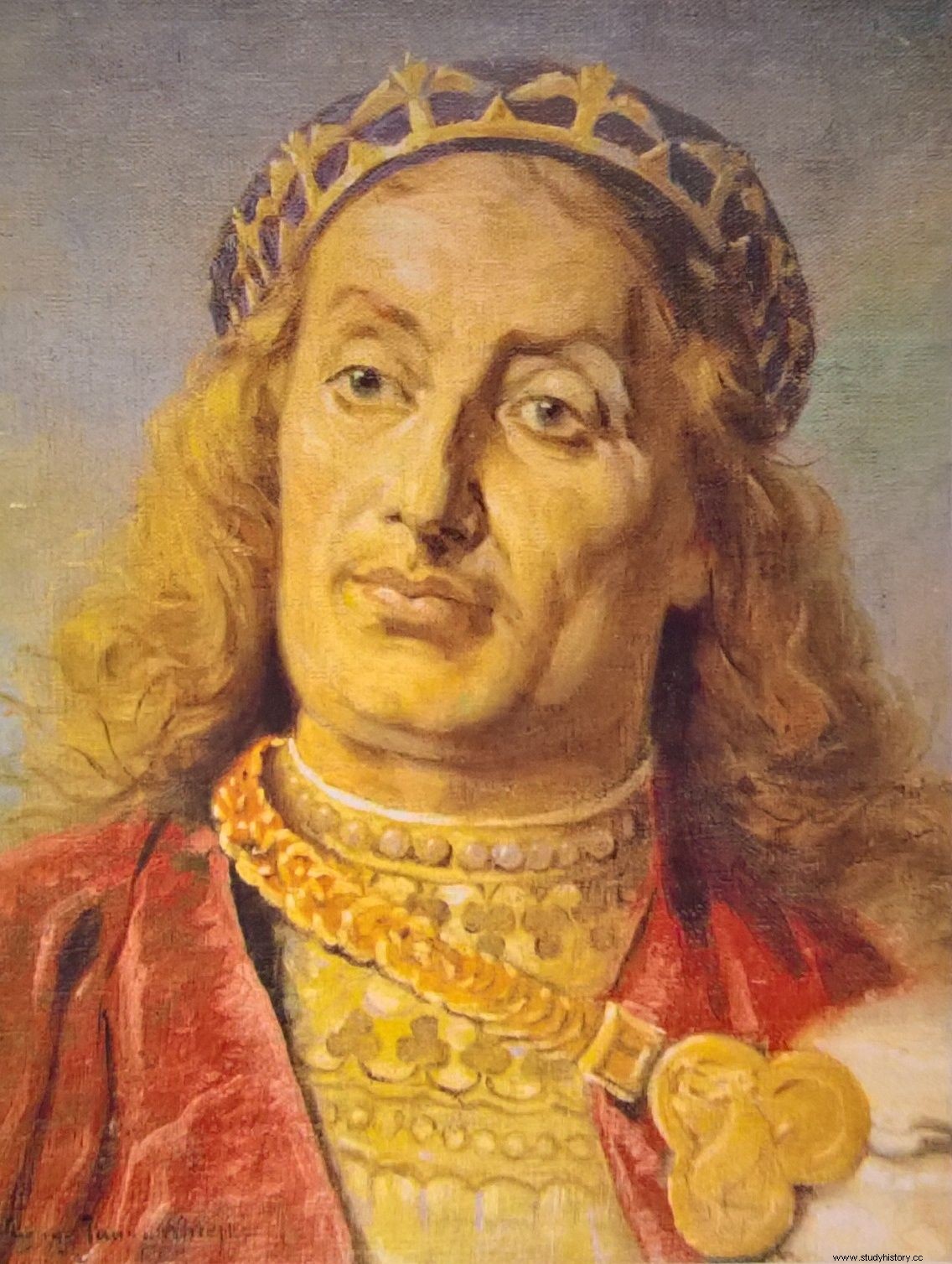
Władysław Laskonogi after Jan Matejko.
In 1205, Laskonogi ruled in Krakow, and Leszek the White was his main rival to the throne. Was it Laskonogi who preventively wanted to get rid of a competitor, or had to bring Roman, because Biały was getting ready to attack Krakow - it is hard to say, and it probably does not matter. More important is the fact that the Battle of Zawichost was in its own way an element of the "Polish-Polish war".
It is clearly visible in the effects. Leszek Biały and Konrad did not go to Ruthenia in order to plunder or subjugate even some of Roman's lands. In 1206, White took over Kraków. Soon after, a young widow of Roman with two young sons Daniel and Wasylek appeared at his court, forced by the opposition to flee from Ruthenia. The prince of Krakow gave shelter to the woman, and recalling his victory over Zawichost and the death of her husband, he said:"It was the devil who sowed hostility between us."
***
You can read about the successes of our weapon in the book “Polish triumphs. 50 glorious battles in our history ” . Learn about the clashes that changed the course of history with this richly illustrated publication. From the victorious battles in the times of Bolesław the Brave to the fierce battles of the Second World War.
Find out more:
- Bieniak J., Roman , [in:] Dictionary of Slavic antiquities , vol. 4, ed. Gerard Labuda, Zdzisław Stieber, PAN Publishing House, Warsaw 1970.
- Dąbrowski D., King of Rus Daniel Romanowicz. About the Ruthenian princely family, society and culture in the 13th century , Avalon Publishing House, Krakow 2016.
- Dąbrowski D., The burial places of the Mścisławowicz family in the 12th and 13th centuries , [in:] In memoriam honororemque Casimiri Jasiński , edited by Jarosław Wenta, Piotr Oliński, Scientific Publishers of the Nicolaus Copernicus University, Toruń 2010.
- Nagirnyj W., Foreign policy of the Principalities of Halych and Volhynia in the years 1198 (1199) –1264 , Polish Academy of Learning, Kraków 2011.
- Słupecki L.P., Battle of Zawichost, 19 June 1205 , [in:] Szkice Zawichojskie , ed. Teresa Dunin-Wąsowicz, Stanisław Tabaczyński, Publishing House of the Institute of Archeology and Ethnology of the Polish Academy of Sciences, Zawichost 1999.
- Szambelan Z., Ruthenian invasions of the Sandomierz region in the 13th century , "Acta Universitatis Lodziensis. Folia Historica ”, vol. 36 (1989).
